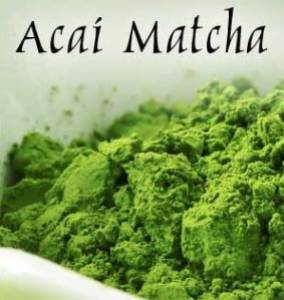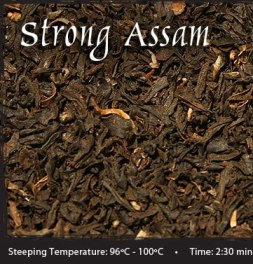Where To Buy: Shanti Tea
Product Description:
No Description on the website YET…brand new offering!
Tasters Review:
(Red) Maple Spice Tea is another new Maple offering from Shanti. This one is pretty good. It pairs a nice sweet Rooibos with some even spices and the Maple flavors are mixed in underneath. It has just enough of all of the flavors without going overboard!
I do like this Maple and More Offering from Shanti Tea but they have some REALLY GOOD Maple offerings right now – some I like more than others – but all of them – I DO LIKE – overall!
Darjeeling Green from Shanti Tea
Leaf Type: Green
Where to Buy: Shanti Tea
Product Description:
This rare Darjeeling green tea is cultivated at about 7000ft in the Himalayas, at the renowned Makaibari Estate, the oldest (est. 1859) and most respected tea estate in the world, and also the world’s first biodynamically cultivated tea garden. This exquisite green tea has a light amber color, a mild, natural aroma and subtle flavor, with delicate floral hints.
Taster’s Review:
I have tried a few teas from Shanti Tea and one thing that I’ve noticed which remains consistent with every tea that I’ve tasted thus far is Shanti Tea’s dedication to delicious, high quality tea. This tea is certainly no exception.
I was surprised to see the dry leaves – they are LARGE! Most of the Darjeeling tea leaves I’ve seen up until now have been a smaller, cut (or torn) leaf, and while these leaves are torn, they are much larger than the small leaves I’m used to seeing when it comes to a Darjeeling. At first glance I would have thought it to be an Oolong. And that’s not the only thing that makes this different from a typical Darjeeling!
The leaves produce a clear, pretty amber colored liquor that is beautifully fragrant. The aroma is somewhat floral but there is also a somewhat toasty/musky/woody kind of scent in there too. It’s quite an interesting bouquet, bringing together feminine floral notes with a warm, masculine undertone.
The taste presents a lovely complexity to the palate, starting with a hint of flowery notes that taste almost jasmine-esque. The floral notes are soon joined by a toasty flavor that is somewhat nut-like, followed by the subtlest note of musky wood. About mid-sip, the slightest taste of sweet pear appears.
The flavor is light and refreshing, and so different from what I’m used to when it comes to a Darjeeling tea. I am used to black Darjeeling teas which tend to be crisp and light in flavor. This one has that crisp, light flavor too, but while a black Darjeeling has the muscatel that tends to come off as a sparkling, wine-like note, this one has more of a rich, toasted nut flavor. This one focuses less on the fruity aspects and more upon the rich, buttery nut taste. The muscatel is still there with this tea, but it is just … different. Deliciously, refreshingly different.
A beautifully complex Darjeeling that causes me to rethink what a Darjeeling is supposed to be. I like that!
Ceylon Forest Green Tea from Shanti Tea
Leaf Type: Green
Where to Buy: Shanti Tea
Product Description:
Reminiscent of a China green, with its vegetal taste, but with a greater degree of fermentation. This rare, rainforest grown tea is mellow yet full-bodied, serene, and uplifting.
Taster’s Review:
This is a delicious green tea. The dry leaves, when I first saw them, didn’t look real green to me, they looked more like an oxidized tea, perhaps not as dark as a black tea, but, not really green, either. After infusing, the wet leaves reveal their true color and are very deep green.
The flavor is delightful. The description states that it is “mellow yet full-bodied, serene and uplifting,” and I agree with that. This does have a vegetative taste, but, it’s much more complex than that. The sip begins with sweetness with a hint of a grassy/vegetative note. About mid-sip, I notice a savory note that is somewhat bitter but not off-putting. It’s actually quite intriguing and I like how it cuts through the sweetness. The sip ends with some astringency, and a sweet, fruity tone lingers in the aftertaste.
This tea is good for a couple of infusions, and I highly recommend taking advantage of that. The second infusion is superior to the first. It is in the second infusion that more fruit tones reveal themselves. I would liken this second infusion to the flavor of apple slices that have been drizzled with honey. It is sweet and very delicious. Definitely a cup you’ll want to savor.
This is a tea I would recommend to all green tea enthusiasts out there! It’s divine!
Acai Matcha from Shanti Tea
Leaf Type: Matcha (Green Tea)
Where to Buy: Shanti Tea
Product Description:
Matcha tea is kind of like a super-powered green tea—since you’re ingesting the whole leaf instead of just the brewed beverage, you get up to ten times the antioxidant effect and nutritional value of your standard green. Matcha’s rich in antioxidants, as well as chlorophyll and fiber, and has been found to have natural mood enhancing effects. All in all, matcha’s got no match when it comes to healthy teas.
Taster’s Review:
This is a really good flavored Matcha. Flavored Matcha is not as common a product as other flavored teas, so it’s an exciting thing to find one.
The flavor is a bit different than other flavored Matcha teas that I’ve tried, I don’t know if that is because this is intended to use to make Matcha Lattes. The first time I tasted it, I enjoyed it as I would normally prepare Matcha – that is with some hot water in my chawan and whisk with my chasen. And this results in a pretty tasty tea.
The flavor is smooth and rich, with very little bitterness. It is a lot less bitter than I usually experience with Matcha (which is typically a little bitter and a little sweet – a delicious contrast). It is also not quite as vegetative. Prepared traditionally, what I taste mostly is a creamy, sweet and rich tasting tea with mere hints of a vegetative taste (it’s kind of in the background!) and a tart note from the Acai berry. It isn’t an unpleasant tartness, though. I’m really enjoying it.

But because I didn’t feel like I was truly experiencing this tea as it was intended, I decided that I should also try this as a latte. I put a few heaping scoops (I used my Chashaku) of the Matcha in my Chawan, and then I made a thick paste using two tablespoons (I eyeball it) of hot (not boiling) water. Then I added steaming milk and whisked it until blended and frothy.
As a latte, I notice that I get more froth than I did preparing it traditionally. The flavor is much creamier, and I notice more of the vegetative notes as a latte, but less of the acai berry, which slowly creeps up to the palate in the finish and imparts a lovely tart note. Not a pucker-y type of tart, just a pleasant, fruity tart taste.
After trying it as a latte, I decided to get a little more adventurous and try it with some orange juice. So using the same method as before (a few heaping scoops, a little hot water, thick paste), I replaced the hot milk with a little bit of cold orange juice. This may be my favorite way to enjoy this particular matcha because I like the way that the acai berry and the orange flavors mingle. There is very little vegetative taste, it is sweet, slightly creamy, and pleasantly tart.
This Matcha is incredibly versatile. It would also make a great addition to a smoothie, if you’re so inclined! I like that the acai berry is subtle, but just enough to help smooth out some of the bitter notes of the Matcha. I really enjoyed my time with this Matcha!
Strong Assam from Shanti Tea
Leaf Type: Black
Where to Buy: Shanti Tea
Product Description:
Fair Trade Certified & Organic Black Tea
This lowland tea known for its rich aroma and strong, malty flavor is named after its origin, Assam, in North-East India. Our Strong Assam tea is cultivated at the famous Rembeng Estate, a 100% organic tea garden and the pioneering organic estate in the region, making their teas highly sought after. Dark and copper-colored, it is a full-bodied broken leaf black tea that is great for lovers of a strong morning cup of tea. The rich flavors are accentuated by adding milk and sugar.
Taster’s Review:
W0w! When they say strong, they mean STRONG! This is one seriously bold, in-your-face Assam!
This is a bold and robust tea, but, there is a lot more going on than just mere strength. It has such a lovely complexity to it. There are delicious undertones of sweetness that remind me of caramelized fruit. This is a note that comes through on the aroma, and carries through to the sip: when I first inhaled the fragrance, I could smell the distinctive caramel scent, and then upon tasting – DELICIOUS!
There are also hints of fruit and spice, as well as a very malty quality to this tea – the combination of the malt and caramel is quite yummy. This combination is further enhanced with a splash of milk as it lends a creaminess to the malt and caramel.
I recommend careful steeping parameters with this one. You don’t need to use a little extra leaf because this tea is plenty strong without it, in fact, you might find that it’s too strong with extra leaf. So I recommend using just 1 teaspoon for your first tasting, and then experimenting to find your perfect cuppa. Also, watch your timer carefully! 2 1/2 minutes is the perfect time for this tea (at least, for me!) but don’t go over 3 minutes for your first tasting, as it will become bitter.
This is delicious hot or iced, but I prefer it hot, it is a delightful “cold, foggy morning” kind of tea! It helps you clear the fog in your head after a not-so-great night’s sleep (or even if you’ve had a good one!) If you’d rather head back to bed, but can’t because you’ve got to “seize the day” – this tea will get you headed in that direction! This tea has got bite to it, so if you need to soften that edge, a little drizzle of agave nectar will do the trick.
An excellent Assam!





